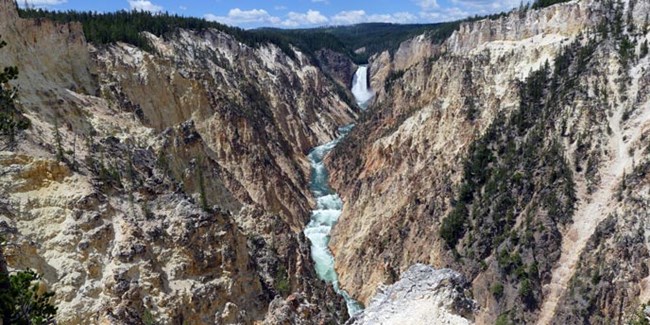
NPS/Diane Renkin Admire the Grand Canyon of the Yellowstone RiverThe Grand Canyon of the Yellowstone is roughly 20 miles long, measured from the Upper Falls to the Tower Fall area. The canyon was formed by erosion as Yellowstone River flowed over progressively softer, less resistant rock. The 109-foot (33.2-m) Upper Falls is upstream of the Lower Falls and can be seen from the Brink of the Upper Falls Trail and from Upper Falls Viewpoints. The 308-foot (93.9-m) Lower Falls can be seen from Lookout Point, Red Rock Point, Artist Point, Brink of the Lower Falls Trail, and from various points on the South Rim Trail. The volume of water flowing over the falls can vary from 63,500 gallons (240,374 l)/second at peak runoff in the spring to 5,000 gallons (18,927 l)/second in the autumn. A third falls is located in the canyon between the Upper and Lower falls. Cascade Creek cascades into the canyon as Crystal Falls. It can be seen from the South Rim Trail just east of the Upper Falls Viewpoints area. 
NPS/Diane Renkin Watch Wildlife in Hayden ValleyHayden Valley is a great place to view wildlife. Grizzly bears may be seen in the spring and early summer preying upon newborn bison and elk calves. Bison are often seen in the spring all the way through the fall rut. Coyotes and foxes are often seen in the valley. Ducks, geese, and American white pelicans cruise the river, while a variety of shore birds may be seen in the mud flats at Alum Creek. Keep an eye out for bald eagles, northern harriers, and sandhill cranes. Safety Tip: Do not approach or surround bears or wolves on foot within 100 yards (91 m) or other wildlife within 25 yards (23 m). Maintain a safe distance from all wildlife. 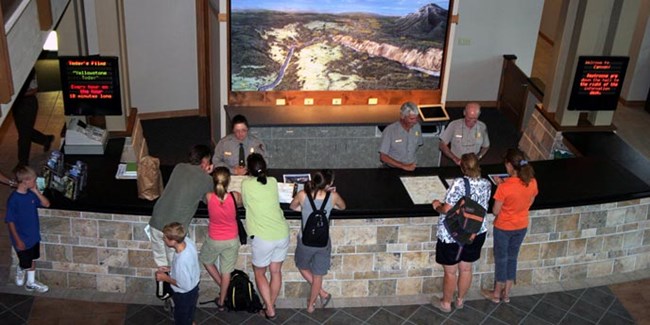
NPS Visit the Canyon Visitor Education CenterThe Canyon Visitor Education Center is located in the Canyon Village complex, part of the Mission 66 project in Yellowstone. The original visitor center was completed in 1957, and the new lodge was open for business in the same year. The current visitor center features exhibits on the Yellowstone Supervolcano, presents park films in the theatre, and provides information via rangers or real-time information displays. 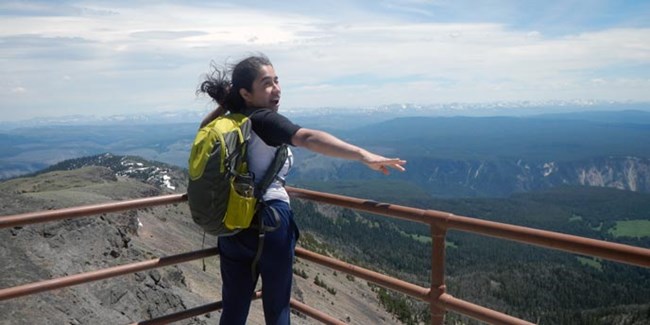
NPS/Yellowstone Youth Conservation Corps Hike to the Top of Mount WashburnWith a peak elevation of 10,219 feet (3,115 m) and panoramic views for about 20 to 50 miles (32 to 80 km), Mount Washburn is a popular day-hiking destinations. It is located just a few miles north of Canyon Village. Mount Washburn is the remnant of volcanic activity that took place long before the formation of the present canyon and named for General Henry Washburn, leader of the 1870 Washburn-Langford-Doane Expedition. At the top, check out interpretive exhibits inside the base of a fire lookout and enjoy the view (you can also watch views from Mount Washburn from two webcams). In addition to being a popular hiking destination, Mount Washburn is one of three fire lookout stations in Yellowstone. It is staffed from mid-June until the fire season ends, during which time the staff watch for signs of fire. Stay HereThis region has two options for staying overnight in Yellowstone: Canyon Lodge and Canyon Campground. 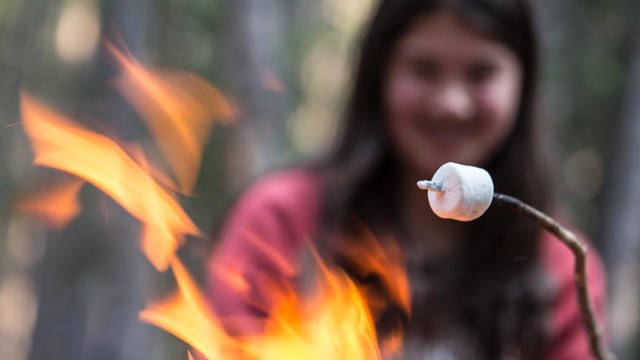
Camp in a Campground
Plan a night in one of twelve park campgrounds. 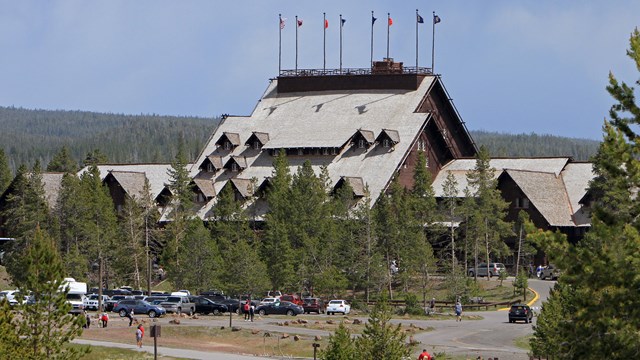
Stay in a Lodge
Pick a lodge that's right for you and make a reservation early! Canyon Area Frequently Asked QuestionsThe Upper Falls are 109 feet (33 m) and the Lower Falls are 308 feet (94 m).
This huge canyon is roughly 20 miles (32 km) long, more than 1,000 feet (305 m) deep, and 1,500 to 4,000 feet (457–1,219 m) wide.
Scientists continue to develop theories about its formation. After the Yellowstone Caldera eruption, 631,000 years ago, lava flows and volcanic tuffs buried the canyon area; but hydrothermal gases and hot water weakened the rock. The river eroded this rock, carving a canyon in the Yellowstone River beginning at Tower Fall and heading upstream to Lower Falls.
North Rim Drive: Walkways at Lookout Point and Brink of the Lower Falls lead to views of both waterfalls (just not both waterfalls from the same location). The longest stretch of accessible trail can be accessed from parking lots at Lookout or Grand View. You can also see the Lower Falls from Red Rock and Inspiration points. South Rim Drive: See the Lower Falls at Artist Point, and from a few places along the South Rim Trail; see the Upper Falls from two viewpoints at Upper Falls Viewpoints. Visit Brink of Upper Falls from a viewing area just off the Grand Loop Road south of Canyon Junction, between the entrances to North and South Rim drives. The canyon bends between the Upper and Lower falls, so there is no location where they can be seen at the same time.
Only one trail in this area leads to the bottom of the canyon—Seven Mile Hole Trail, a strenuous, steep round trip of 10.2 miles.
You could say the canyon is "rusting." The colors are caused by oxidation of iron compounds in the rhyolite rock, which has been hydrothermally altered ("cooked"). The colors indicate the presence or absence of water in the individual iron compounds and hydration of minerals in the rock. Most of the yellows in the canyon result from iron and sulfur in the rock.
The volume varies from 63,500 gallons (or 240,000 liters) per second at peak runoff to 5,000 gallons (or 18,900 liters) per second in the late fall.
The natural color of the water. A notch in the lip of the brink makes the water deeper and keeps it from mixing with air and becoming frothy, so the color is visible as it goes over the edge.
No. It is thought that some sketches were made from Moran Point and that multiple canyon views were incorporated into the final painting.
Inside the canyon, look for osprey soaring over the river or perched on their five-foot (1.5 m)-diameter nests. They nest here from late April until early September. Also look for ravens and swallows. During July, a variety of butterflies feast on the abundant flowers in the meadows. Hayden Valley, which begins approximately five miles (8 km) south of Canyon Junction, is one of the best places in the park to view a wide variety of large mammals. Grizzly bears are often seen in the spring and early summer. Large herds of bison may be seen in the spring, early summer, and during the rut in August. Coyotes can almost always be seen in the valley; wolves are often seen as well. Mount Washburn is another excellent place for viewing wildlife. Bighorn sheep and marmots can be seen on its slopes in the summer. Wolves and bears are sometimes seen. Elk and bison frequent the valley north of the mountain. 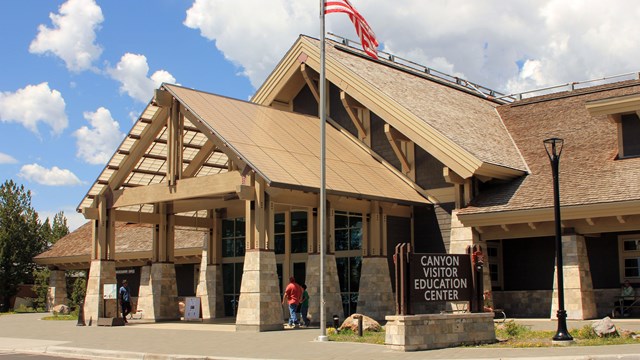
Canyon Visitor Education Center
See, hear, and learn how the Yellowstone volcano, its geysers and hot springs, and geologic history shape the area's ecosystems. 
Canyon Hikes
Hike around the Grand Canyon of the Yellowstone River to see mountains and canyons. 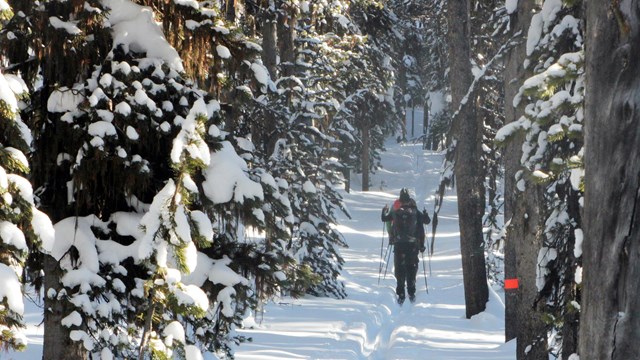
Canyon Trails
Discover the skiing and snowshoeing opportunities around the Grand Canyon of the Yellowstone River. 
Accessibility
Discover Yellowstone's accessibility resources like the NPS Mobile App, Access Pass, and assistive services. 
Current Conditions
What conditions can you expect during your trip to Yellowstone? Find out here. 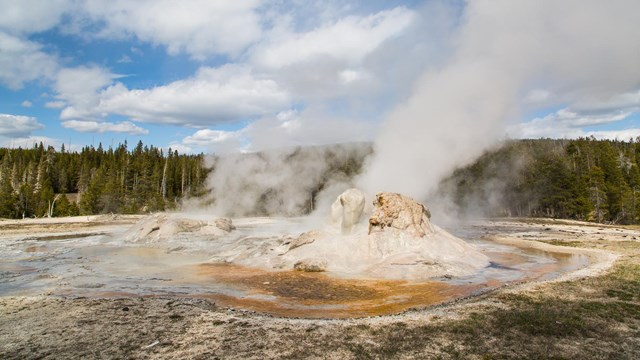
Places To Go
Discover the highlights of Yellowstone's vast 2.2 million acres, ten visitor centers, and eight developed areas. 
Plan Your Visit
Yellowstone changes with the seasons—make the most of your visit! Plan ahead to keep your trip safe, fun, and unforgettable. |
Last updated: April 30, 2025
